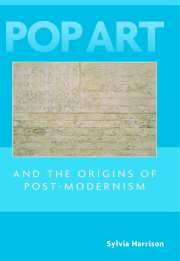Book contents
- Frontmatter
- Contents
- Introduction
- PART ONE THEORETICAL FRAMEWORK
- PART TWO “SOCIAL” CRITICS
- 2 Lawrence Alloway: Pop Art and the “Pop Art-Fine Art Continuum”
- 3 Harold Rosenberg: Pop Art and the “De-definition” of Both Art and “Self”
- 4 Leo Steinberg: Pop, “Post-Modernist” Painting and the Flatbed Picture Plane
- PART THREE “PHILOSOPHICAL” CRITICS
- PART FOUR “CULTURAL” CRITICS
- Conclusion
- Notes
- Index
3 - Harold Rosenberg: Pop Art and the “De-definition” of Both Art and “Self”
from PART TWO - “SOCIAL” CRITICS
Published online by Cambridge University Press: 23 July 2009
- Frontmatter
- Contents
- Introduction
- PART ONE THEORETICAL FRAMEWORK
- PART TWO “SOCIAL” CRITICS
- 2 Lawrence Alloway: Pop Art and the “Pop Art-Fine Art Continuum”
- 3 Harold Rosenberg: Pop Art and the “De-definition” of Both Art and “Self”
- 4 Leo Steinberg: Pop, “Post-Modernist” Painting and the Flatbed Picture Plane
- PART THREE “PHILOSOPHICAL” CRITICS
- PART FOUR “CULTURAL” CRITICS
- Conclusion
- Notes
- Index
Summary
Harold Rosenberg's writings on pop art throughout the sixties, in which he constantly demonstrates pop's questioning and blurring of the boundaries between mass and fine art, provide the most compelling evidence of grounds for art's anxious condition – those derived from the key technological and economic characteristics of post-war society – as opposed to evidence of the condition itself. According to Rosenberg, anxious art confronts its situation and exercises art's prerogative to make itself anew, while its anxiety is evidence of art's survival in the face of a situation that militates against its very being. Pop, in Rosenberg's terms, is evidence of a stilling of art's disquiet. With its seeming acquiescence to art's “deformation” and “loss of identity,” pop renounces the “intellectual and emotional” element in modern art that stems from confronting the truth of its condition, replacing it, presumably, by a craftsman's satisfaction “in doing.”
Rosenberg's account of pop art's threatened merger with mass communication forms places it within the ambit of the delegitimizing interests of post-modernism, those that propose an end to categorical distinctions based upon hierarchies of taste, opinion, and knowledge as well as an end to the power of singular authorities, such as the art museum, to dictate categorical distinctions along these lines.
- Type
- Chapter
- Information
- Pop Art and the Origins of Post-Modernism , pp. 68 - 95Publisher: Cambridge University PressPrint publication year: 2001



